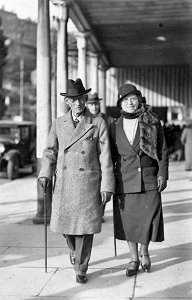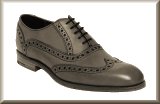
Samuel Edge. This
photograph was probably taken on holiday in Torquay. |
Paul Leadbeater recalls much of the later twentieth century progress
of the firm from his own experience but, with the added benefit of all
his father told him of the earlier years, almost the entire life of the
firm is within memory. It is believed that Paul's father was one of
"Sammy's Rabbits" to begin with and joined the firm officially as he
left school. Our Edge story can also be supplemented from the memories
of many other past Edge employees.
The majority of them were women, with
the obvious increase in proportion during the war years. One lady
recalls her mother's Second World War experience, telling of a return to
work, along Wolverhampton Street one lunchtime, and seeing aircraft
engaged in a "dog fight" overhead!
Amongst the famous shoe names being supplied through the wholesale
trade were: Lilley and Skinner, Dolcis, Timpson, Freeman Hardy and
Willis, Truform, Saxone, and some for the Wolverhampton boot and shoe
makers, Bakers. At some time unknown Samuel Edge remarried to a member of staff at
Edge shoes. Her first name was Hattie, but nothing else is known about
her. |
|
Frederick Lett was the Company Secretary and he married
Sam's daughter Phillipa. Howard's daughter married a clergyman, the
Reverend Thomas N. V. C. Rose-Price, around the year 1940. They had two
children, Heather and Robin.
The Edge family had a particular love of Torquay, where
many of the family holidays were taken.
Samuel Edge died on the first of August 1934 and was
buried with his first wife, Naomi, at Bilston Cemetery. His son, Howard
Nume Edge, succeeded his father. Unlike his father he was a tall figure
walking around the works.
Howard's reign as owner was not without its problems. It
is believed that a case of embezzlement arose within the senior staff
and the culprit successfully absconded with the proceeds. But the trade
of most shoe manufacturers was in decline during those years. Howard
retired and endorsed the family preference by retiring to Torquay, where
he died on the 21st August 1968.
|

Samuel and his second wife, Hattie.
|
During the years that followed Edge's became part of
Neville Developments, who put in a former London factory owner, named
Scotton, as manager. Whilst at Edge's Mr Scotton was taken ill and the
management was taken over by his son, John Scotton, who had been brought
in as a designer, having Art qualifications.
The Edge family obviously had retained a financial
interest in the firm and the Rose-Prices held shares. After Howard's
death it appears that his daughter sold her shares to Neville
Developments. The Scotton family were not able to purchase the firm at
this point.
Neville Developments put one man on the Board of
Directors, a Lotus man and related to a well known name in the trade,
the Bostock family of Stafford. This appears to have been a very
successful period in the Edge Shoes history.
During the Second World War both Phillipa and Frederick
Lett died, Phillipa in 1941 and Frederick in 1944. Both were buried at
Bilston in the family grave.
It seems that for a large part of the life of the
business an outlet shop existed in Bilston Town supplementing, by retail
sales, those achievements of sales progressively increasing through the
wholesale trade. During the Neville's time a Factory Shop was built on
the site of Billy Rock's cycle shop on the corner of Wellington Road and
Wolverhampton Street. Later a warehouse and basement store for the boxes
was added. The girders are still in place that would have accommodated a
further floor.

This advert appears to be
from the 1950s. Edges were claiming to have been established
for 70 years. |
In the early 1960s millionaire Charles Clore began
building up the British Shoe Corporation and many of the larger shoe
firms, with factories, became a part. Truform were at Northampton, while
Freeman, Hardy and Willis were at Leicester. These were two of the
larger components of the alliance. The Corporation decided to buy-in
shoes from smaller manufacturers too, and Edge's became involved in this
way.
There was, however, a restriction on the types of shoes
manufactured to accommodate the B. S. C. plans, e.g. Littles of
Netherton made walking boots. Bakers of Wolverhampton had their own
lines and Edges theirs, so that there would be no overproduction and
undue competition amongst the members. |
Workmen entrusted with cutting the valuable leather were
traditionally known as "clickers" throughout the trade. This was because
of the clicking noise the knife made when being withdrawn from the
leather laid out on its good solid board that had previously been soaked
in linseed oil. On this wooden board, with its grain uppermost, the skin
was scraped flat, usually by using a piece of broken band-saw blade.
Originally the suppliers of the leather marked the skins
with wax crayons in 1/4s of a square foot and on this basis they
charged. The irregular shape of any animal skin made it extremely
difficult to measure in 1/4s of a square foot accurately.
Paul remembers the day when he was entrusted with
handling a new machine, purchased by the firm, which could calculate the
area accurately. It was at his father's prompting that he asked for the
job! He recalls that, in the days when the suppliers quoted the area,
overcharging was rife, while with the new machine he was able to save
the firm £100 on the very first consignment of leather he measured!
Another recollection was that Saturday mornings were used for the
gathering together of small clippings of leather and their conversion
into bows.
The Second World War interrupted Paul's time at Edge's
but he returned there from the navy on demobilisation.
Paul had seen the transition in manufacture from being
built piece by piece to components being bought-in. He recalls the
Military Heels being built, piece by piece, and shaped actually onto the
shoe. He does recall one embarrassing consignment, bound for Madagascar,
which was returned owing to an unfortunate choice of adhesive. The heat
of the country proved too much and resulted in the glue melting and the
shoes falling apart. A different formula glue had to be found and was
used after this.
In addition to Madagascar foreign exports included
Russia, America, Scandinavia and France. Consignments to the cold
climates had to be securely packed in strong plywood boxes and were
shipped by Lloyds. The period after the Second World War began with shoe
assembly being carried out in the traditional way, with all parts made
on the ground. Yet soon factory procedures changed with the times to
meet new requirements. Insoles changed from being cut on site to being
bought in. Shoe design was still undertaken at the factory by Edge's
staff.
There was another influence for change in the arrival of
new materials, all of which affected the design and construction of the
shoes. There was the introduction of resin soles and, as an alternative
to leather, plastics, which were shaped using infra-red heaters. The
shoe parts arrived simply needing assembly. Often unseen are the metal
shanks giving strength to the shoes, previously unnecessary in all
leather old style shoes.
With the exception of local deliveries, contractors now
took long distance consignments, Dawson's of Walsall being one of the
companies used.
The years of heavy industrial decline in Britain seemed
to be reflected in Edge's production. The factory base weakened and John
Scotton sold out his interest in the firm to a Mr Singh but became a
freelance salesman acting for the firm.
He described the problems in 2000 AD as being brought
about by the influx of cheaper goods from abroad. This was affecting the
shoe market as much as any other industry. At this time the workforce
was markedly reduced and some of the machinery seemed to have been sold
on. A quieter atmosphere pervaded the workrooms. The Brewery Side had
been sold for some years and is now a Sikh Temple, as can be seen in the
illustration on the previous page.
However, whenever speaking to Edge's workers there seems
to be a real sense of pleasure in recalling their time working for the
company, particularly that a family atmosphere seems to have existed
there. Works coach outings to the seaside are recalled with nostalgia.
One of its lady employees recalls an experience as her wedding
approached when the manager asked if she had everything ready? After
conversation a pair of shoes was made up for her on the spot to match
her wedding outfit!
One fascinating find recently made in the town of
Whitchurch has been an archaeological examination of two shops in
Watergate Street with a square arched entrance between them. The roof
beams of both shops have been examined and dated by dendrochronology.
The dates of the timbers were identical and used in a construction of
1615! They must be of the lost Raven Inn and the arch between would have
led to the yard around which were the dwellings in which Samuel Edge was
born!
In the Summer of 2002 the business premises in
Wellington Road carried the notice "To Let". If this marks the end of
Edge Shoes it has survived for a Century - not a bad record in today's
world!
I wish to thank all those who have contributed to the
story as shown, particularly to Phil and Gordon Edge and other members
of the family; Mr John Scotton; Paul Leadbeater, Derek Barratt and other
workers who have shared their reminiscences with me; and Tom Larkin who
persuaded me to attempt the investigation.
 |
|
 |
Return to
the
previous page |
|
Return
to the
Other Trades Hall |
|

